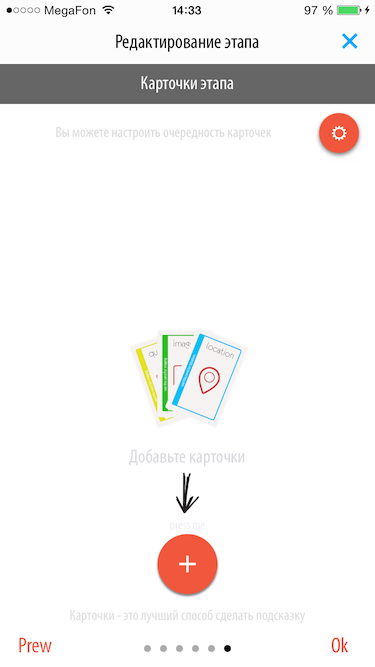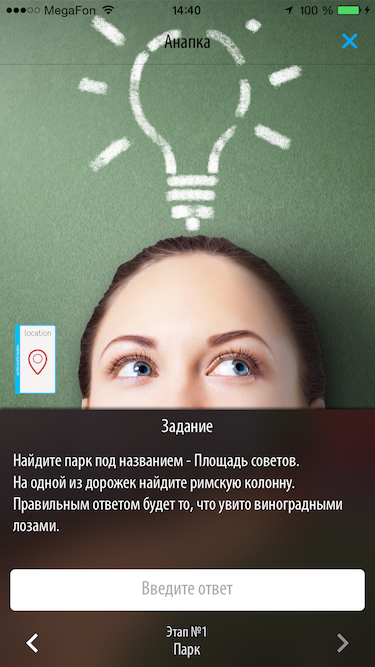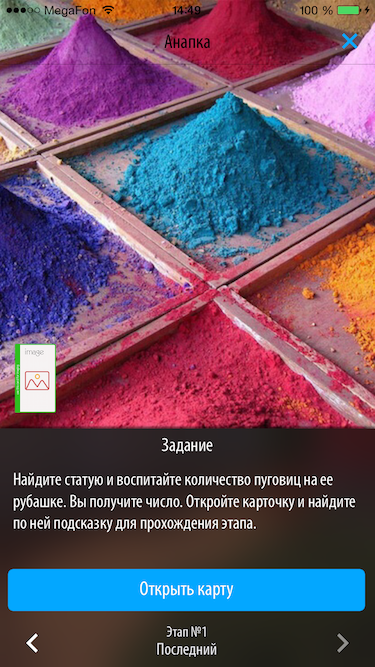Cards for the quest. What it is?
We continue the theme of creating quests.
The other day, our application was updated and such a strange, at first glance, thing as Cards was added to it.
What it is and why they are needed - these are the questions that I will raise today.
This is a hint, just not a text one, but in the form of a picture or coordinates on a map. You can add a card from the settings of the stage, just go to the last page and press the big round button.
')

The system offers us to choose the type of card, after which either a map is opened with a choice of coordinates, or a photo album is opened in which we can choose any picture as a card.
I will start, perhaps, with an example that will sufficiently show the need to use such functionality when developing your own quest.
Suppose one of the stages of the quest is to search for any attraction. For example, a miniature Roman column, the vines of which are wrapped around a ball standing on its top. So we write the task: “find the column”, and in the field for the answer we indicate what they twist around (the answer is the Ball). But here's the bad luck - how to explain to a person where to look for this column? You can, of course, write that it is located in a park at such and such an alley, but if a person does not know the city sufficiently, then he will have to open the map on the phone, turn on the Internet, search for this street or park. You have to agree that no one needs so many unnecessary actions, and in order to avoid them, you can add a geo-position card at the time of drawing up the stage, in which the coordinates of this park will be indicated for you. When passing the stage, this card will be available to a person and he will be able to open a map with a specified point with a single tap and, without unnecessary gestures, find a park and start searching.

This thing is quite specific, but I think it will be used. It can be used for intermediate hints. Suppose you need to take a person along a certain route. Then the task may sound like this: “Find the statue and count the number of buttons on its shirt (there are 11 of them). You will get a number. Open the card. Under the number 11 you will find further instructions "(some table is drawn on the card). Thus the game form will be formed during the passage of the quest.

All this can be used and combined in any way; here I have cited just one of the examples. We believe that the more flexible the application will be, the more versatile and interesting quests will be.
If you want to test the application, then go to the site and leave a request for testing.
The other day, our application was updated and such a strange, at first glance, thing as Cards was added to it.
What it is and why they are needed - these are the questions that I will raise today.
What it is?
This is a hint, just not a text one, but in the form of a picture or coordinates on a map. You can add a card from the settings of the stage, just go to the last page and press the big round button.
')

The system offers us to choose the type of card, after which either a map is opened with a choice of coordinates, or a photo album is opened in which we can choose any picture as a card.
I will start, perhaps, with an example that will sufficiently show the need to use such functionality when developing your own quest.
Geo-location card
Suppose one of the stages of the quest is to search for any attraction. For example, a miniature Roman column, the vines of which are wrapped around a ball standing on its top. So we write the task: “find the column”, and in the field for the answer we indicate what they twist around (the answer is the Ball). But here's the bad luck - how to explain to a person where to look for this column? You can, of course, write that it is located in a park at such and such an alley, but if a person does not know the city sufficiently, then he will have to open the map on the phone, turn on the Internet, search for this street or park. You have to agree that no one needs so many unnecessary actions, and in order to avoid them, you can add a geo-position card at the time of drawing up the stage, in which the coordinates of this park will be indicated for you. When passing the stage, this card will be available to a person and he will be able to open a map with a specified point with a single tap and, without unnecessary gestures, find a park and start searching.

Picture Card
This thing is quite specific, but I think it will be used. It can be used for intermediate hints. Suppose you need to take a person along a certain route. Then the task may sound like this: “Find the statue and count the number of buttons on its shirt (there are 11 of them). You will get a number. Open the card. Under the number 11 you will find further instructions "(some table is drawn on the card). Thus the game form will be formed during the passage of the quest.

All this can be used and combined in any way; here I have cited just one of the examples. We believe that the more flexible the application will be, the more versatile and interesting quests will be.
If you want to test the application, then go to the site and leave a request for testing.
Source: https://habr.com/ru/post/292448/
All Articles